✗ Close categories
 Addiction
Addiction
 Apple
Apple
 Arts
Arts
 Asia News
Asia News
 British Airways
British Airways
 Business
Business
 Cars
Cars
 Celebrity
Celebrity
 Christianity
Christianity
 Cinema, Theater & TV
Cinema, Theater & TV
 Conspiracy Theories
Conspiracy Theories
 Coronavirus
Coronavirus
 Ebola
Ebola
 Economy
Economy
 Education
Education
 Electronics
Electronics
 Entertainment
Entertainment
 Environment
Environment
 Fashion
Fashion
 Finance
Finance
 Food
Food
 Funny videos
Funny videos
 Gadgets
Gadgets
 Games
Games
 General News
General News
 Health
Health
 International Crime
International Crime
 Jobs
Jobs
 Lifestyle
Lifestyle
 Military
Military
 Mindfulness
Mindfulness
 Movies
Movies
 Music
Music
 News videos
News videos
 NewsPhoto
NewsPhoto
 Nightlife
Nightlife
 Obituaries
Obituaries
 Olympics
Olympics
 Organized Crime
Organized Crime
 Politics
Politics
 Psychology
Psychology
 Recipes
Recipes
 Royal Family
Royal Family
 Sci-Tech
Sci-Tech
 Science
Science
 Social media
Social media
 Sport
Sport
 Technology
Technology
 Television
Television
 Thames Deckway
Thames Deckway
 Traffic
Traffic
 Travel
Travel
 Trending UK
Trending UK
 UK News
UK News
 UnitedHealth Group Inc.
UnitedHealth Group Inc.
 Weather
Weather
 World News
World News
✗ Close categories
✗ Close categories
✗ Close categories
 Arsenal
Arsenal
 Aston Villa
Aston Villa
 Athletics
Athletics
 Badminton
Badminton
 Baseball
Baseball
 Basketball
Basketball
 Blackburn Rovers
Blackburn Rovers
 Blackpool
Blackpool
 Boxing
Boxing
 Burnley
Burnley
 Cardiff City
Cardiff City
 Champions League
Champions League
 Chelsea
Chelsea
 Cricket
Cricket
 Crystal Palace
Crystal Palace
 Cycling
Cycling
 Darts
Darts
 Everton
Everton
 Formula 1
Formula 1
 Formula 1 - Force India Videos
Formula 1 - Force India Videos
 Formula 1 - Infiniti Red Bull Racing Videos
Formula 1 - Infiniti Red Bull Racing Videos
 Formula 1 - Live Stream & News
Formula 1 - Live Stream & News
 Formula 1 - McLaren Videos
Formula 1 - McLaren Videos
 Formula 1 - Mercedes AMG Petronas Videos
Formula 1 - Mercedes AMG Petronas Videos
 Formula 1 - Sauber F1 Team Videos
Formula 1 - Sauber F1 Team Videos
 Formula 1 - Scuderia Ferrari Videos
Formula 1 - Scuderia Ferrari Videos
 Formula 1 - Scuderia Toro Rosso Videos
Formula 1 - Scuderia Toro Rosso Videos
 Formula 1 - Team Lotus Videos
Formula 1 - Team Lotus Videos
 Formula 1 - Williams Martini videos
Formula 1 - Williams Martini videos
 Fulham
Fulham
 Golf
Golf
 Hockey
Hockey
 Horse Racing
Horse Racing
 Hull City
Hull City
 Ice Hockey
Ice Hockey
 Leicester City
Leicester City
 Liverpool
Liverpool
 Manchester City
Manchester City
 Manchester United
Manchester United
 Middlesbrough
Middlesbrough
 Motorsport
Motorsport
 Norwich City
Norwich City
 Philadelphia Phillies
Philadelphia Phillies
 Premier League
Premier League
 Queens Park Rangers
Queens Park Rangers
 Rally
Rally
 Reading
Reading
 Rowing
Rowing
 Rugby
Rugby
 scarlets rugby
scarlets rugby
 Soccer
Soccer
 Southampton
Southampton
 Stoke City
Stoke City
 Sunderland
Sunderland
 Swansea City
Swansea City
 Swimming
Swimming
 Tennis
Tennis
 Tottenham
Tottenham
 Tour de France
Tour de France
 Volleyball
Volleyball
 WC soccer 2014
WC soccer 2014
 Welsh Rugby Union
Welsh Rugby Union
 West Ham
West Ham
 Wigan Athletic
Wigan Athletic
 Wolverhampton Wanderers
Wolverhampton Wanderers
✗ Close categories
✗ Close categories
✗ Close categories
 ...test
...test
 Aberdeen City
Aberdeen City
 Aberdeenshire
Aberdeenshire
 Antrim
Antrim
 Aylesbury Vale
Aylesbury Vale
 Barking and Dagenham
Barking and Dagenham
 Barnet
Barnet
 Barnsley
Barnsley
 Basildon
Basildon
 Bath and North East Somerset
Bath and North East Somerset
 Belfast
Belfast
 Bexley
Bexley
 Birmingham
Birmingham
 Blackburn with Darwen
Blackburn with Darwen
 Bolton
Bolton
 Bournemouth
Bournemouth
 Bradford
Bradford
 Brent
Brent
 Brighton and Hove
Brighton and Hove
 Bristol
Bristol
 Bromley
Bromley
 Bury
Bury
 Calderdale
Calderdale
 Cambridge
Cambridge
 Camden
Camden
 Cardiff
Cardiff
 Central Bedfordshire
Central Bedfordshire
 Cheshire East
Cheshire East
 Cheshire West and Chester
Cheshire West and Chester
 Cornwall
Cornwall
 County Durham
County Durham
 Coventry
Coventry
 Croydon
Croydon
 Derby
Derby
 Doncaster
Doncaster
 Dudley
Dudley
 Ealing
Ealing
 East Riding of Yorkshire
East Riding of Yorkshire
 Edinburgh
Edinburgh
 Enfield
Enfield
 Essex
Essex
 Gateshead
Gateshead
 Glasgow
Glasgow
 Greater London
Greater London
 Greenwich
Greenwich
 Hackney
Hackney
 Hammersmith and Fulham
Hammersmith and Fulham
 Haringey
Haringey
 Harrow
Harrow
 Havering
Havering
 Herefordshire
Herefordshire
 Hillingdon
Hillingdon
 Hounslow
Hounslow
 Hull
Hull
 Islington
Islington
 Kirklees
Kirklees
 Lambeth
Lambeth
 Leeds
Leeds
 Leicester
Leicester
 Lewisham
Lewisham
 Liverpool
Liverpool
 London
London
 Luton
Luton
 Manchester
Manchester
 Medway
Medway
 Merton
Merton
 Milton Keynes
Milton Keynes
 New Forest
New Forest
 Newcastle
Newcastle
 Newcastle upon Tyne
Newcastle upon Tyne
 Newham
Newham
 North Somerset
North Somerset
 North Tyneside
North Tyneside
 North West
North West
 Northampton
Northampton
 Northern Ireland
Northern Ireland
 Northumberland
Northumberland
 Nottingham
Nottingham
 Oldham
Oldham
 Oxford
Oxford
 Peterborough
Peterborough
 Plymouth
Plymouth
 Portsmouth
Portsmouth
 Redbridge
Redbridge
 Richmond upon Thames
Richmond upon Thames
 Rochdale
Rochdale
 Rotherham
Rotherham
 Salford
Salford
 Sandwell
Sandwell
 Scotland
Scotland
 Sefton
Sefton
 Sheffield
Sheffield
 Shropshire
Shropshire
 Solihull
Solihull
 South East
South East
 South Gloucestershire
South Gloucestershire
 South West
South West
 Southampton
Southampton
 Southend-on-Sea
Southend-on-Sea
 Southwark
Southwark
 St Helens
St Helens
 Stockport
Stockport
 Stockton-on-Tees
Stockton-on-Tees
 Stoke-on-Trent
Stoke-on-Trent
 Sunderland
Sunderland
 Sutton
Sutton
 Swindon
Swindon
 Tameside
Tameside
 Tower Hamlets
Tower Hamlets
 Trafford
Trafford
 Wakefield
Wakefield
 Wales
Wales
 Walsall
Walsall
 Waltham Forest
Waltham Forest
 Wandsworth
Wandsworth
 Warrington
Warrington
 West Midlands
West Midlands
 Westminster
Westminster
 Wigan
Wigan
 Wiltshire
Wiltshire
 Wirral
Wirral
 Wolverhampton
Wolverhampton
 York
York
✗ Close categories
✗ Close categories
✗ Close categories
 Harry Styles
Harry Styles
 Aaron Taylor-Johnson
Aaron Taylor-Johnson
 Adele
Adele
 Ashley Cole
Ashley Cole
 Benedict Cumberbatch
Benedict Cumberbatch
 Billie Piper
Billie Piper
 Boris Johnson
Boris Johnson
 Charlie Hunnam
Charlie Hunnam
 Cliff Richard
Cliff Richard
 David Beckham
David Beckham
 DJ 3lau
DJ 3lau
 DJ Above & Beyond
DJ Above & Beyond
 DJ Afrojack
DJ Afrojack
 DJ Alesso
DJ Alesso
 DJ Aly & Fila
DJ Aly & Fila
 DJ Andrew Rayel
DJ Andrew Rayel
 DJ Angerfist
DJ Angerfist
 DJ Armin Van Buuren
DJ Armin Van Buuren
 DJ Arty
DJ Arty
 DJ ATB
DJ ATB
 DJ Audien
DJ Audien
 DJ Avicii
DJ Avicii
 DJ Axwell
DJ Axwell
 DJ Bingo Players
DJ Bingo Players
 DJ Bl3ND
DJ Bl3ND
 DJ Blasterjaxx
DJ Blasterjaxx
 DJ Borgeous
DJ Borgeous
 DJ Borgore
DJ Borgore
 DJ Boy George
DJ Boy George
 DJ Brennan Heart
DJ Brennan Heart
 DJ Calvin Harris
DJ Calvin Harris
 DJ Carl Cox
DJ Carl Cox
 DJ Carnage
DJ Carnage
 DJ Code Black
DJ Code Black
 DJ Coone
DJ Coone
 DJ Cosmic Gate
DJ Cosmic Gate
 DJ Da Tweekaz
DJ Da Tweekaz
 DJ Dada Life
DJ Dada Life
 DJ Daft Punk
DJ Daft Punk
 DJ Dannic
DJ Dannic
 DJ Dash Berlin
DJ Dash Berlin
 DJ David Guetta
DJ David Guetta
 DJ Deadmau5
DJ Deadmau5
 DJ Deorro
DJ Deorro
 DJ Diego Miranda
DJ Diego Miranda
 DJ Dillon Francis
DJ Dillon Francis
 DJ Dimitri Vegas & Like Mike
DJ Dimitri Vegas & Like Mike
 DJ Diplo
DJ Diplo
 DJ Don Diablo
DJ Don Diablo
 DJ DVBBS
DJ DVBBS
 DJ Dyro
DJ Dyro
 DJ Eric Prydz
DJ Eric Prydz
 DJ Fedde Le Grand
DJ Fedde Le Grand
 DJ Felguk
DJ Felguk
 DJ Ferry Corsten
DJ Ferry Corsten
 DJ Firebeatz
DJ Firebeatz
 DJ Frontliner
DJ Frontliner
 DJ Gabry Ponte
DJ Gabry Ponte
 DJ Gareth Emery
DJ Gareth Emery
 DJ Hardwell
DJ Hardwell
 DJ Headhunterz
DJ Headhunterz
 DJ Heatbeat
DJ Heatbeat
 DJ Infected Mushroom
DJ Infected Mushroom
 DJ John O'Callaghan
DJ John O'Callaghan
 DJ Kaskade
DJ Kaskade
 DJ Knife Party
DJ Knife Party
 DJ Krewella
DJ Krewella
 DJ Kura
DJ Kura
 DJ Laidback Luke
DJ Laidback Luke
 DJ Madeon
DJ Madeon
 DJ MAKJ
DJ MAKJ
 DJ Markus Schulz
DJ Markus Schulz
 DJ Martin Garrix
DJ Martin Garrix
 DJ Merk & Kremont
DJ Merk & Kremont
 DJ Mike Candys
DJ Mike Candys
 DJ Nervo
DJ Nervo
 DJ Nicky Romero
DJ Nicky Romero
 DJ Noisecontrollers
DJ Noisecontrollers
 DJ Oliver Heldens
DJ Oliver Heldens
 DJ Orjan Nilsen
DJ Orjan Nilsen
 DJ Paul Van Dyk
DJ Paul Van Dyk
 DJ Porter Robinson
DJ Porter Robinson
 DJ Quentin Mosimann
DJ Quentin Mosimann
 DJ Quintino
DJ Quintino
 DJ R3hab
DJ R3hab
 DJ Radical Redemption
DJ Radical Redemption
 DJ Richie Hawtin
DJ Richie Hawtin
 DJ Sander Van Doorn
DJ Sander Van Doorn
 DJ Sebastian Ingrosso
DJ Sebastian Ingrosso
 DJ Showtek
DJ Showtek
 DJ Skrillex
DJ Skrillex
 DJ Snake
DJ Snake
 DJ Steve Angello
DJ Steve Angello
 DJ Steve Aoki
DJ Steve Aoki
 DJ Tenishia
DJ Tenishia
 DJ The Chainsmokers
DJ The Chainsmokers
 DJ Tiddey
DJ Tiddey
 DJ Tiesto
DJ Tiesto
 DJ TJR
DJ TJR
 DJ Umek
DJ Umek
 DJ Ummet Ozcan
DJ Ummet Ozcan
 DJ Vicetone
DJ Vicetone
 DJ VINAI
DJ VINAI
 DJ W&W
DJ W&W
 DJ Wildstylez
DJ Wildstylez
 DJ Wolfpack
DJ Wolfpack
 DJ Yves V
DJ Yves V
 DJ Zatox
DJ Zatox
 DJ Zedd
DJ Zedd
 DJ Zomboy
DJ Zomboy
 Emilia Clarke
Emilia Clarke
 Emily Blunt
Emily Blunt
 Gabriella Wilde
Gabriella Wilde
 Gary Lineker
Gary Lineker
 Gemma Arterton
Gemma Arterton
 Gwendoline Christie
Gwendoline Christie
 Hayley Atwell
Hayley Atwell
 Helena Bonham Carter
Helena Bonham Carter
 Imogen Poots
Imogen Poots
 Jason Statham
Jason Statham
 John Terry
John Terry
 Juno Temple
Juno Temple
 Kate Beckinsale
Kate Beckinsale
 Kate Winslet
Kate Winslet
 Keira Knightley
Keira Knightley
 Liam Payne
Liam Payne
 Lily Collins
Lily Collins
 Louis Tomlinson
Louis Tomlinson
 Niall Horan
Niall Horan
 Nicholas Hoult
Nicholas Hoult
 Paul McCartney
Paul McCartney
 Prince William
Prince William
 Ralph Fiennes
Ralph Fiennes
 Richard Branson
Richard Branson
 Robbie Williams
Robbie Williams
 Robert Pattinson
Robert Pattinson
 Rosamund Pike
Rosamund Pike
 Sophie Turner
Sophie Turner
 Theo James
Theo James
 Tom Hardy
Tom Hardy
 Tom Hiddleston
Tom Hiddleston
 Tony Blair
Tony Blair
 Tyree Cooper
Tyree Cooper
 Wayne Rooney
Wayne Rooney
 Zayn Malik
Zayn Malik
✗ Close categories
✗ Close categories
✗ Close categories
 Accountancy
Accountancy
 Administration
Administration
 Advertising
Advertising
 Aerospace
Aerospace
 Agriculture
Agriculture
 Analyst
Analyst
 Animals
Animals
 Antiques
Antiques
 Archaeology
Archaeology
 Architecture
Architecture
 Arts
Arts
 Astrology
Astrology
 Astronomy
Astronomy
 Auto News
Auto News
 Automotive
Automotive
 Aviation
Aviation
 Bakery
Bakery
 Biotechnology
Biotechnology
 Brazil
Brazil
 Cabaret
Cabaret
 Call Centre
Call Centre
 Car News
Car News
 Care
Care
 Catering
Catering
 Charities
Charities
 Chemistry
Chemistry
 Child care
Child care
 Cinema, Theater & TV
Cinema, Theater & TV
 Cleaning Industry
Cleaning Industry
 Coaching
Coaching
 Construction
Construction
 Customs
Customs
 Dairy industry
Dairy industry
 Dance & ballet
Dance & ballet
 Debt collection agencies
Debt collection agencies
 Defense
Defense
 DJ
DJ
 Economy
Economy
 Education & Training
Education & Training
 Electrical
Electrical
 Entrepreneur
Entrepreneur
 Farming & Agriculture
Farming & Agriculture
 Financial
Financial
 Firefighter
Firefighter
 Fisheries
Fisheries
 Flowers
Flowers
 FMCG
FMCG
 Food
Food
 Fruit & Vegetables
Fruit & Vegetables
 Genealogy
Genealogy
 General News
General News
 Government
Government
 Hair stylist
Hair stylist
 Hotel
Hotel
 HR & Recruitment
HR & Recruitment
 ICT
ICT
 Insurance
Insurance
 IT Executive
IT Executive
 Jobs
Jobs
 Justice
Justice
 Landscaper
Landscaper
 Lawyer
Lawyer
 Legal
Legal
 Library
Library
 Logistics
Logistics
 Marketing
Marketing
 Meat industry
Meat industry
 Medical Industry
Medical Industry
 Mining
Mining
 Nurse
Nurse
 Online Trends
Online Trends
 Pharmaceutical Industry
Pharmaceutical Industry
 Pharmacy
Pharmacy
 Physical therapy
Physical therapy
 Police
Police
 Political
Political
 PR Public relations
PR Public relations
 Production & Industry
Production & Industry
 Project Management
Project Management
 Psychology
Psychology
 Public Transport
Public Transport
 Publisher
Publisher
 Real estate
Real estate
 Research & Development
Research & Development
 Restaurant
Restaurant
 Retail
Retail
 Sales & Marketing
Sales & Marketing
 Security
Security
 SEO
SEO
 Shipping
Shipping
 Social work
Social work
 Sustainable Energy
Sustainable Energy
 Teacher
Teacher
 Telecom
Telecom
 Tourism
Tourism
 Traditional Energy
Traditional Energy
 Transport
Transport
 Travel Industry
Travel Industry
 Web Design
Web Design
✗ Close categories
✗ Close categories
-
Excavating the CA archives – Tintagel
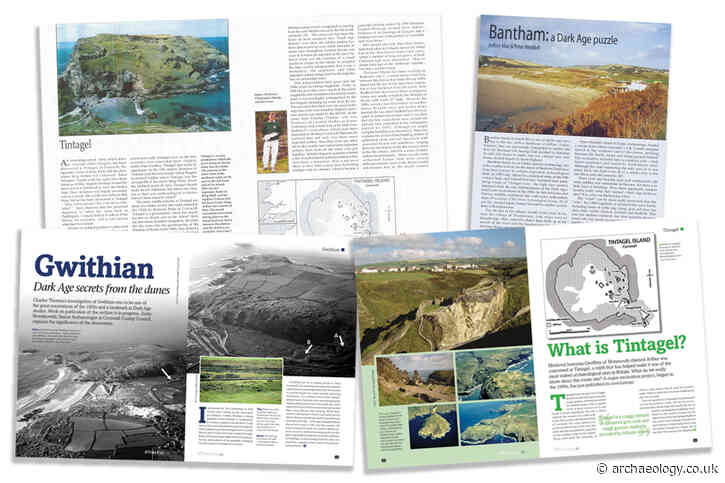 Tintagel in Cornwall can be considered a ‘great site’ for a number of reasons, depending on personal perspective. For some, the draw is its rich archaeology; for others, its links to King Arthur, or its dramatic coastal settings. Perhaps it is a combination of all of these, alongside the inevitable controversies that come with being one of the most visited historic sites in the UK. It is loved, loathed, and hotly debated: see, for example, considerations of its new bridge in CA 352 (
Tintagel in Cornwall can be considered a ‘great site’ for a number of reasons, depending on personal perspective. For some, the draw is its rich archaeology; for others, its links to King Arthur, or its dramatic coastal settings. Perhaps it is a combination of all of these, alongside the inevitable controversies that come with being one of the most visited historic sites in the UK. It is loved, loathed, and hotly debated: see, for example, considerations of its new bridge in CA 352 ( -
Excavating the CA archives – Roman Chester
Roman Chester – Deva Victrix – is one of the unquestioned ‘great sites’ of Roman Britain. This was a major military centre from its late 1st-century AD origins through to its abandonment in the late 4th/early 5th centuries AD, and significant parts of the town survive beneath the medieval and modern city. Current Archaeology has been on site there since the start of the magazine, and its repeated visits shine a light not just on the evolution of the town, but also on its -
A Roman landscape revealed: Celebrating 20 years of the Culver Archaeological Project
Two decades of excavations in East Sussex farmland have uncovered the remains of an unusual enclosed settlement linking the Roman road network with the River Ouse. Rob Wallace and David Millum explain more.The Culver Archaeological Project has been investigating Roman features beside the River Ouse since 2005. Here we see a typical day in Trench 6 in 2017.
North of Lewes in East Sussex, the Upper Ouse Valley is home to an archaeological landscape rich with Roman remains, including evidence of in -
Current Archaeology 423 – ON SALE NOW
…or perhaps that should be ‘Happy Birthday’ – to the project featured on this month’s cover. Founded in 2005, the Culver Archaeological Project has for the last two decades been uncovering a fascinating Roman landscape – including an unusual enclosed settlement – beside the River Ouse in East Sussex. With the initiative now marking its 20th anniversary, we explore some of its key findings to-date.Turning from a long-running excavation to a newly announc -
Excavating the CA archives – Offa’s Dyke
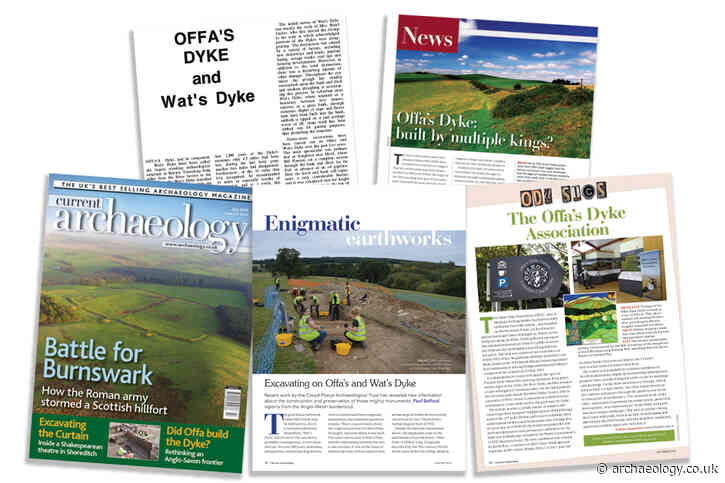 In 1978, Current Archaeology arrived on the scene of works begun six years prior by Manchester University, which surveyed Offa’s Dyke and neighbouring Wat’s Dyke.
In 1978, Current Archaeology arrived on the scene of works begun six years prior by Manchester University, which surveyed Offa’s Dyke and neighbouring Wat’s Dyke.
My column this month is on one of the least-known ‘great sites’ of all: Offa’s Dyke, the linear earthwork that stretches along the Welsh/English border. Most people know Hadrian’s Wall, and a fair few the Antonine Wall, but how many of us can say that we are familiar with Offa’s Dyke, either t -
Warhorse: Discovering the archaeology of a medieval revolution
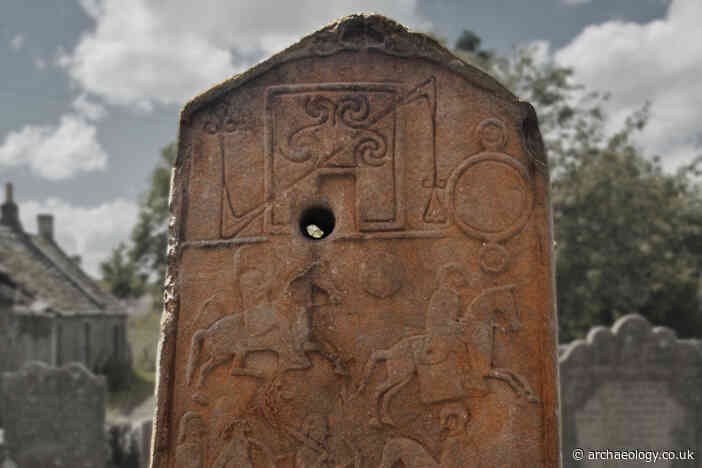 Mighty warhorses, as richly adorned and armoured as their knightly riders, are an immediately recognisable icon of the medieval period. Until recently, they were understood mainly through analysis of written sources – but what can archaeology add to this picture? Oliver H Creighton, Robert Liddiard, Alan K Outram, Katherine Kanne, Carly Ameen, and Robert Webley explore the key findings of their recently published research.This reconstruction of a jouster of c.1500, seated on an armoured ho
Mighty warhorses, as richly adorned and armoured as their knightly riders, are an immediately recognisable icon of the medieval period. Until recently, they were understood mainly through analysis of written sources – but what can archaeology add to this picture? Oliver H Creighton, Robert Liddiard, Alan K Outram, Katherine Kanne, Carly Ameen, and Robert Webley explore the key findings of their recently published research.This reconstruction of a jouster of c.1500, seated on an armoured ho -
Current Archaeology 422 – ON SALE NOW
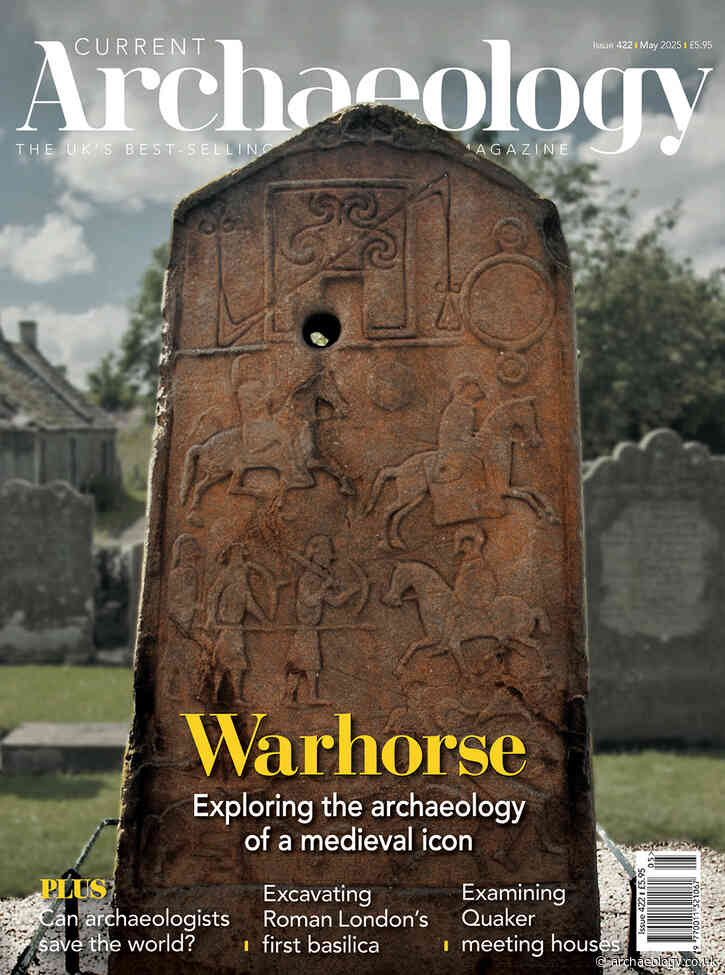 This month’s cover shows Aberlemno II, a 2.28m-tall Pictish cross slab in Angus. Thought to date to the 8th century, its front depicts a large, elaborately decorated ring-headed cross, while the reverse feature the vivid imagery shown on our cover. Some have suggested that it represents the AD 685 Battle of Nechtansmere between the Picts and the Angles, and while other interpretations have been offered, the stone’s detailed depiction of mounted warriors certainly makes a striking sce
This month’s cover shows Aberlemno II, a 2.28m-tall Pictish cross slab in Angus. Thought to date to the 8th century, its front depicts a large, elaborately decorated ring-headed cross, while the reverse feature the vivid imagery shown on our cover. Some have suggested that it represents the AD 685 Battle of Nechtansmere between the Picts and the Angles, and while other interpretations have been offered, the stone’s detailed depiction of mounted warriors certainly makes a striking sce -
Distilling a clandestine craft: Exploring the archaeology and history of illicit whisky-making
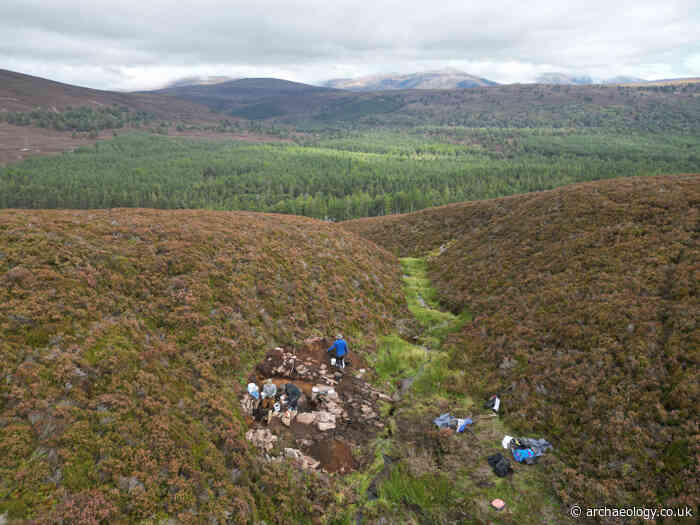 To avoid paying tax, in the 18th and 19th century, small-scale whisky-production went underground, moving to isolated bothies hidden in remote locations across Scotland. Derek Alexander and Daniel Rhodes describe recent archaeological fieldwork by the National Trust for Scotland, in partnership with The Glenlivet, which has been hunting down these sites across the Highlands and bringing their illicit remains to light once more.Overlooking the picturesque but carefully concealed site of Calan&rsq
To avoid paying tax, in the 18th and 19th century, small-scale whisky-production went underground, moving to isolated bothies hidden in remote locations across Scotland. Derek Alexander and Daniel Rhodes describe recent archaeological fieldwork by the National Trust for Scotland, in partnership with The Glenlivet, which has been hunting down these sites across the Highlands and bringing their illicit remains to light once more.Overlooking the picturesque but carefully concealed site of Calan&rsq -
Current Archaeology 421 – ON SALE NOW
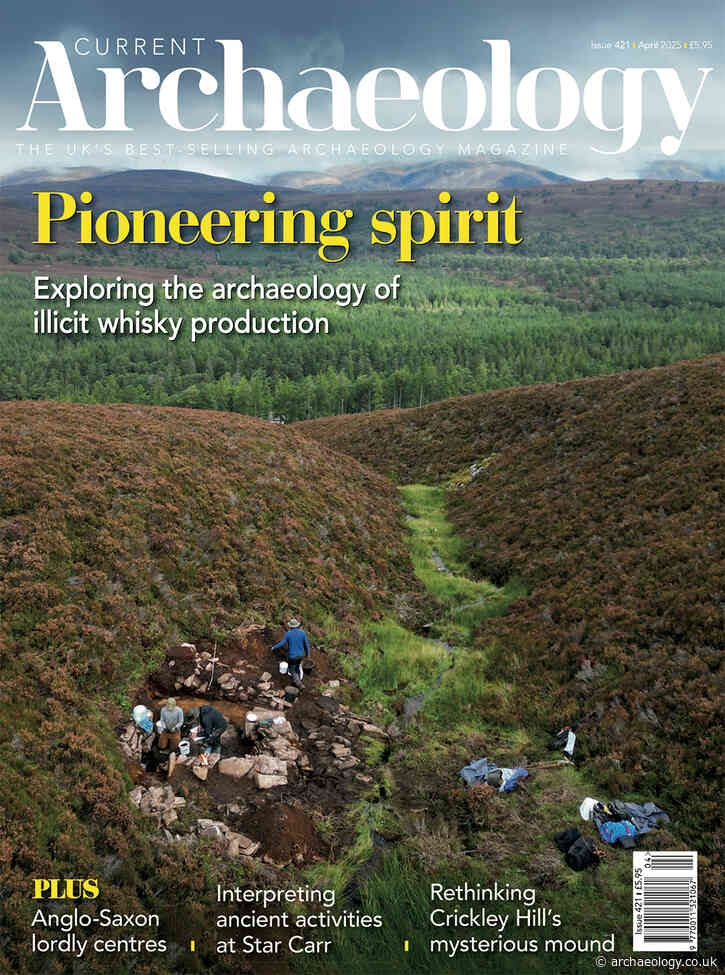 The spectacular scenery adorning this month’s cover features a Highland site known as ‘Calan’s Bothy’ – once home to an illicit whisky still. What has recent fieldwork revealed about this industry in 18th- and 19th-century Scotland?From stunning views to a royal loo, our next feature reveals how the discovery of an early medieval latrine at Bosham in West Sussex held the key to identifying an important power centre associated with Harold II. What can this location,
The spectacular scenery adorning this month’s cover features a Highland site known as ‘Calan’s Bothy’ – once home to an illicit whisky still. What has recent fieldwork revealed about this industry in 18th- and 19th-century Scotland?From stunning views to a royal loo, our next feature reveals how the discovery of an early medieval latrine at Bosham in West Sussex held the key to identifying an important power centre associated with Harold II. What can this location, -
Current Archaeology 421
 The spectacular scenery adorning this month’s cover features a Highland site known as ‘Calan’s Bothy’ – once home to an illicit whisky still. What has recent fieldwork revealed about this industry in 18th- and 19th-century Scotland?From stunning views to a royal loo, our next feature reveals how the discovery of an early medieval latrine at Bosham in West Sussex held the key to identifying an important power centre associated with Harold II. What can this location,
The spectacular scenery adorning this month’s cover features a Highland site known as ‘Calan’s Bothy’ – once home to an illicit whisky still. What has recent fieldwork revealed about this industry in 18th- and 19th-century Scotland?From stunning views to a royal loo, our next feature reveals how the discovery of an early medieval latrine at Bosham in West Sussex held the key to identifying an important power centre associated with Harold II. What can this location, -
PRESS RELEASE: Professor Joyce Tyldesley wins Archaeologist of the Year for 2025
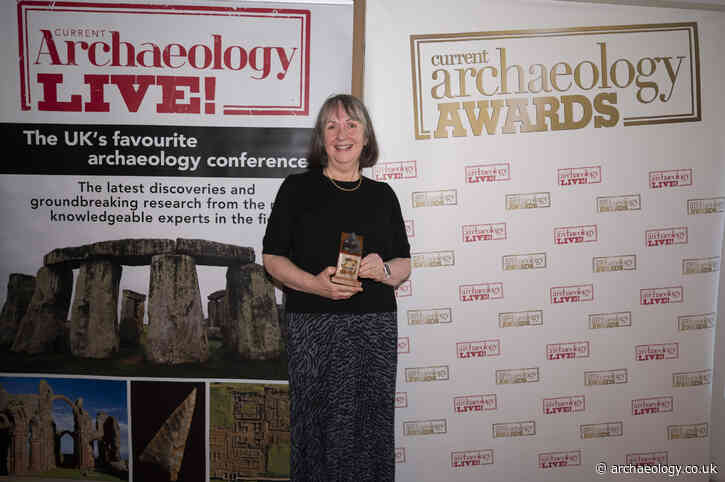 Joyce Tyldesley (Winner of Archaeologist of the Year 2025) [Photo credit: Adam Stanford, www.adam-stanford.co.uk]A Professor who emphasises making archaeology accessible to all has taken home top honours at the prestigious Current Archaeology Awards, after being crowned Archaeologist of the Year for 2025.Joyce Tyldesley, Professor of Egyptology at the University of Manchester, has shown a career-long determination to make the past accessible to as wide an audience as possible, having taught arch
Joyce Tyldesley (Winner of Archaeologist of the Year 2025) [Photo credit: Adam Stanford, www.adam-stanford.co.uk]A Professor who emphasises making archaeology accessible to all has taken home top honours at the prestigious Current Archaeology Awards, after being crowned Archaeologist of the Year for 2025.Joyce Tyldesley, Professor of Egyptology at the University of Manchester, has shown a career-long determination to make the past accessible to as wide an audience as possible, having taught arch -
PRESS RELEASE: Excavations distilling the story of Scottish whisky win Current Archaeology’s prestigious Research Project of the Year award for 2025.
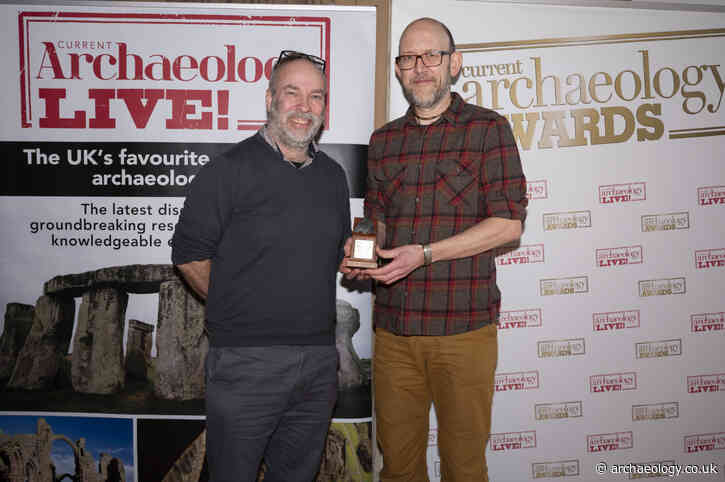 Derek Alexander and Dr Daniel Rhodes (National Trust for Scotland, winners of Research Project of the Year 2025) [Photo credit: Adam Stanford, www.adam-stanford.co.uk]A unique partnership between archaeologists and whisky distillers, investigating the illicit production of Scotland’s iconic spirit during the 18th and 19th centuries, has been crowned 2025’s Research Project of the Year in the prestigious Current Archaeology Awards.In order to avoid tax, many small-scale whisky produce
Derek Alexander and Dr Daniel Rhodes (National Trust for Scotland, winners of Research Project of the Year 2025) [Photo credit: Adam Stanford, www.adam-stanford.co.uk]A unique partnership between archaeologists and whisky distillers, investigating the illicit production of Scotland’s iconic spirit during the 18th and 19th centuries, has been crowned 2025’s Research Project of the Year in the prestigious Current Archaeology Awards.In order to avoid tax, many small-scale whisky produce -
PRESS RELEASE: Excavations uncovering the ‘birthplace of Sheffield’ win Current Archaeology’s prestigious Rescue Project of the Year Award for 2025.
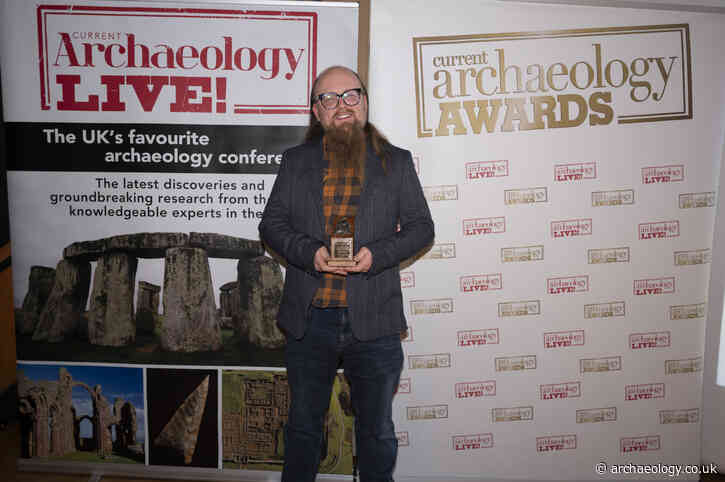 Ashley Tuck (Wessex Archaeology, winner of Rescue Project of the Year 2025) [Photo credit Adam Stanford, www.adam-stanford.co.uk]A community-centred excavation revealing the long-hidden remains of Sheffield Castle has taken home a coveted prize at the annual Current Archaeology Awards.Long before the white heat of the Industrial Revolution forged Sheffield into the ‘City of Steel’, its landscape was dominated by an imposing Norman castle, built to guard a strategic double river-cross
Ashley Tuck (Wessex Archaeology, winner of Rescue Project of the Year 2025) [Photo credit Adam Stanford, www.adam-stanford.co.uk]A community-centred excavation revealing the long-hidden remains of Sheffield Castle has taken home a coveted prize at the annual Current Archaeology Awards.Long before the white heat of the Industrial Revolution forged Sheffield into the ‘City of Steel’, its landscape was dominated by an imposing Norman castle, built to guard a strategic double river-cross -
PRESS RELEASE: Alice Roberts’ book exploring medieval burials wins Current Archaeology’s prestigious Book of the Year award for 2025
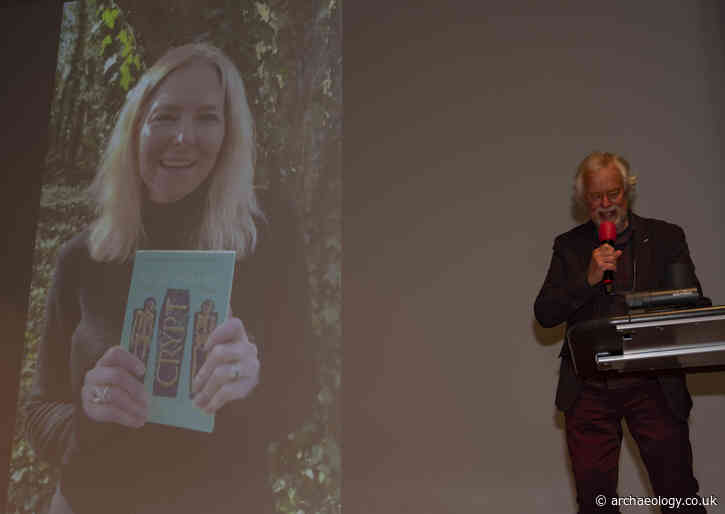 Prof Alice Roberts (winner of Book of the Year 2025) via video message, with archaeologist and educator Julian Richards on stage. [Photo credit: Adam Stanford, www.adam-stanford.co.uk]A vividly written book by archaeological TV presenter, academic, and author Professor Alice Roberts, exploring the lives of ordinary people in the Middle Ages, has taken home a coveted prize at the annual Current Archaeology Awards.Crypt: life, death, and disease in the Middle Ages and beyond traces tells the stori
Prof Alice Roberts (winner of Book of the Year 2025) via video message, with archaeologist and educator Julian Richards on stage. [Photo credit: Adam Stanford, www.adam-stanford.co.uk]A vividly written book by archaeological TV presenter, academic, and author Professor Alice Roberts, exploring the lives of ordinary people in the Middle Ages, has taken home a coveted prize at the annual Current Archaeology Awards.Crypt: life, death, and disease in the Middle Ages and beyond traces tells the stori -
Roman recycling at Reedham: Exploring the imperial origins of a Norfolk church
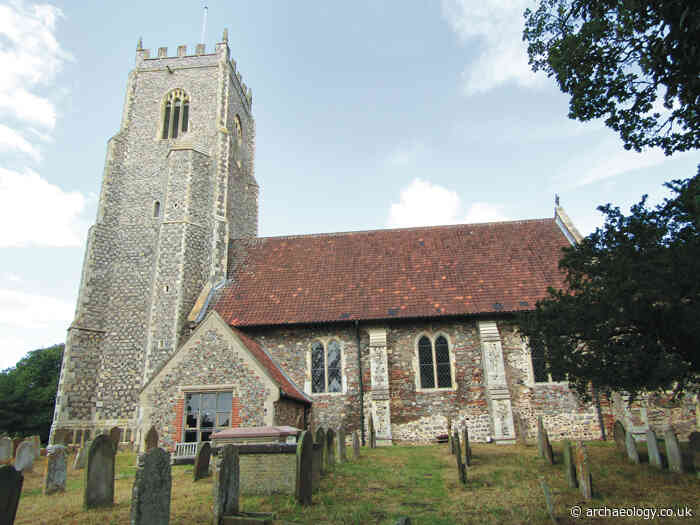 Some 12 miles east of Norwich, Reedham’s church of St John the Baptist has a distinctive appearance, dominated by reused Roman stone, brick, and tile. Mike Fulford describes how archaeological research has identified a potential source for this material: a possibly military predecessor preserved beneath the existing medieval structure.Reedham’s parish church stands out from Norfolk’s many other medieval churches due to the large amount of Roman brick, tile, and stone that has b
Some 12 miles east of Norwich, Reedham’s church of St John the Baptist has a distinctive appearance, dominated by reused Roman stone, brick, and tile. Mike Fulford describes how archaeological research has identified a potential source for this material: a possibly military predecessor preserved beneath the existing medieval structure.Reedham’s parish church stands out from Norfolk’s many other medieval churches due to the large amount of Roman brick, tile, and stone that has b -
Excavating the CA archives – the ships of Dover and Newport
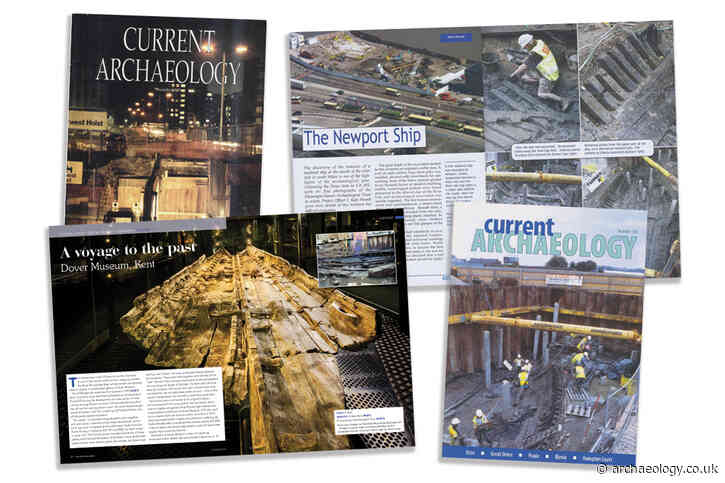 My ‘great’ site this month comprises two sites – actually, two ships – linked by common stories of survival against the odds. In September 1992, the remains of a boat dating to the Middle Bronze Age were discovered in central Dover by workers constructing part of the A20 link road leading to Folkestone. A decade later, in June 2002, the skeleton of a mid-15th-century ship was discovered during the construction of a new arts centre in the middle of Newport. These are two o
My ‘great’ site this month comprises two sites – actually, two ships – linked by common stories of survival against the odds. In September 1992, the remains of a boat dating to the Middle Bronze Age were discovered in central Dover by workers constructing part of the A20 link road leading to Folkestone. A decade later, in June 2002, the skeleton of a mid-15th-century ship was discovered during the construction of a new arts centre in the middle of Newport. These are two o -
Current Archaeology 420 – ON SALE NOW
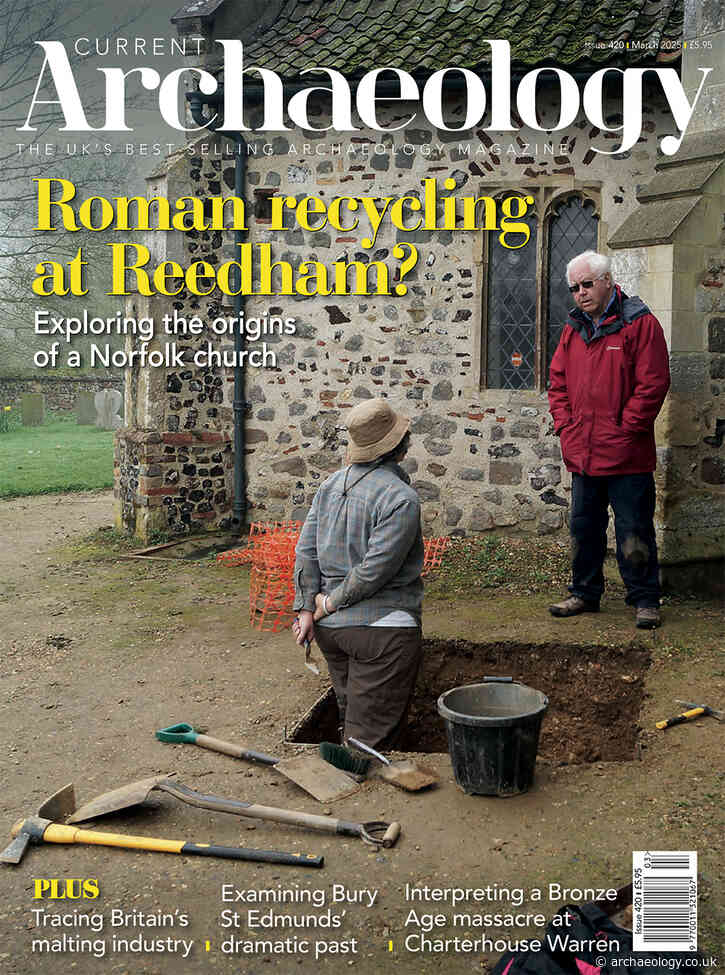 This month’s articles follow two main themes, highlighting the latest insights from the worlds of historic architecture and archaeological science. We begin in the latter category, with two reports drawing on recently published research. The first covers intriguing analysis of ancient adhesives and how they were used between the 5th century BC and the 1st century AD; this is followed by a recent DNA study that has transformed our understanding of migration patterns across Europe in the 1st
This month’s articles follow two main themes, highlighting the latest insights from the worlds of historic architecture and archaeological science. We begin in the latter category, with two reports drawing on recently published research. The first covers intriguing analysis of ancient adhesives and how they were used between the 5th century BC and the 1st century AD; this is followed by a recent DNA study that has transformed our understanding of migration patterns across Europe in the 1st -
Fields of Gold: Understanding the Snettisham Hoards
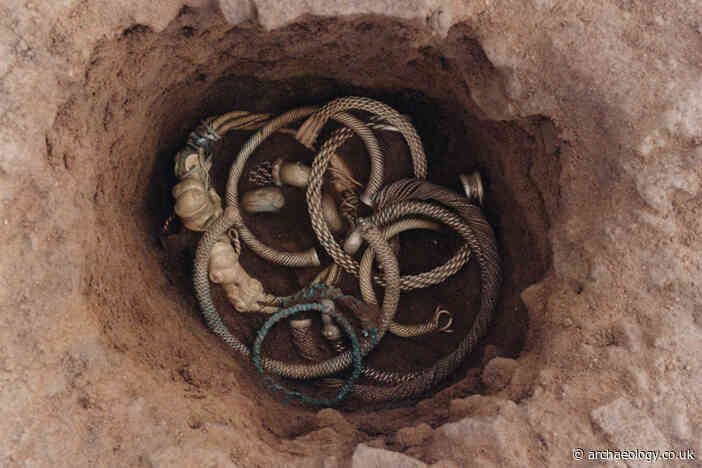 Over the course of eight decades, at least 14 separate hoards of Iron Age metalwork have been recovered from a single field at Snettisham in Norfolk. Now, following the publication of a new book describing the excavation, conservation, and scientific investigation of these spectacular finds, Jody Joy and Julia Farley describe how they came to be discovered, and reveal some of the secrets that have come to light since then.Overlooking the ‘gold field’ near Snettisham in winter 1990; t
Over the course of eight decades, at least 14 separate hoards of Iron Age metalwork have been recovered from a single field at Snettisham in Norfolk. Now, following the publication of a new book describing the excavation, conservation, and scientific investigation of these spectacular finds, Jody Joy and Julia Farley describe how they came to be discovered, and reveal some of the secrets that have come to light since then.Overlooking the ‘gold field’ near Snettisham in winter 1990; t -
Excavating the CA archives – Fishbourne Roman Palace
 My ‘great site’ this month is one close to many people’s hearts. When I think of the locations that embody the best of Current Archaeology as a magazine and British archaeology as a community, I consistently alight on Fishbourne Roman Palace in West Sussex. This site has it all – great coverage in the magazine, enthusiastic public engagement, stunning finds, and charismatic custodians.Fishbourne made the cover of one of CA’s earliest issues, which covered the excava
My ‘great site’ this month is one close to many people’s hearts. When I think of the locations that embody the best of Current Archaeology as a magazine and British archaeology as a community, I consistently alight on Fishbourne Roman Palace in West Sussex. This site has it all – great coverage in the magazine, enthusiastic public engagement, stunning finds, and charismatic custodians.Fishbourne made the cover of one of CA’s earliest issues, which covered the excava -
Current Archaeology 419 – ON SALE NOW
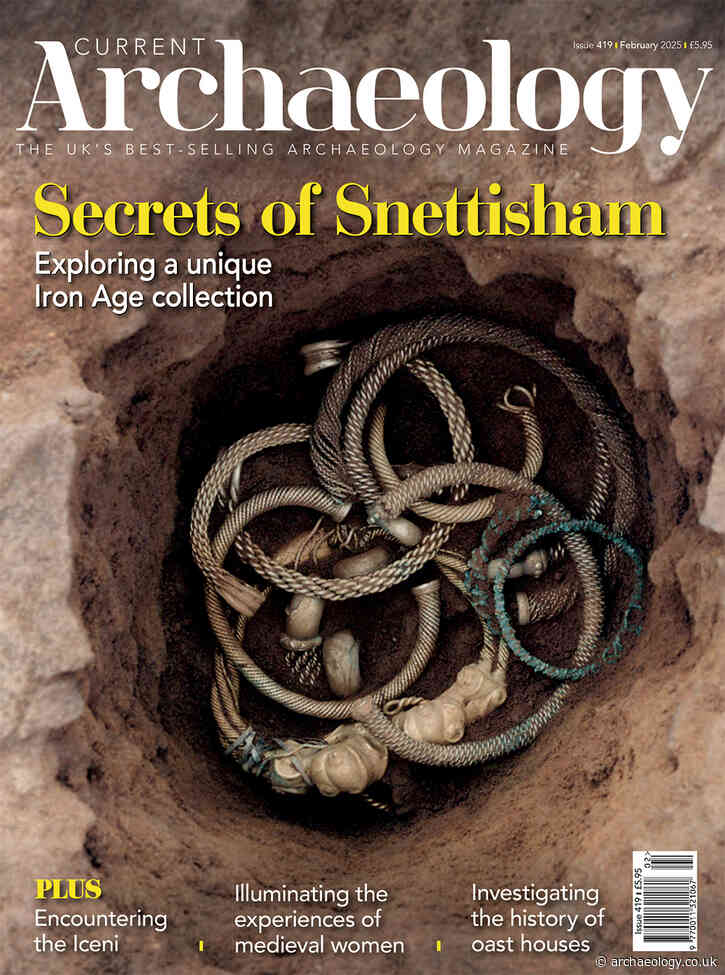 Happy New Year! Our cover story takes us to Snettisham in Norfolk, where a single field has yielded at least 14 Iron Age metalwork hoards. This unique collection has the potential to transform our understanding of ancient artistry and ceremonial practices – and, with analysis of the hoards now published in exciting detail, we explore what has been revealed.
Happy New Year! Our cover story takes us to Snettisham in Norfolk, where a single field has yielded at least 14 Iron Age metalwork hoards. This unique collection has the potential to transform our understanding of ancient artistry and ceremonial practices – and, with analysis of the hoards now published in exciting detail, we explore what has been revealed.
From long-buried metalwork to long-buried stories, we next examine what archives and archaeology can tell us about female experiences -
Current Archaeology 419
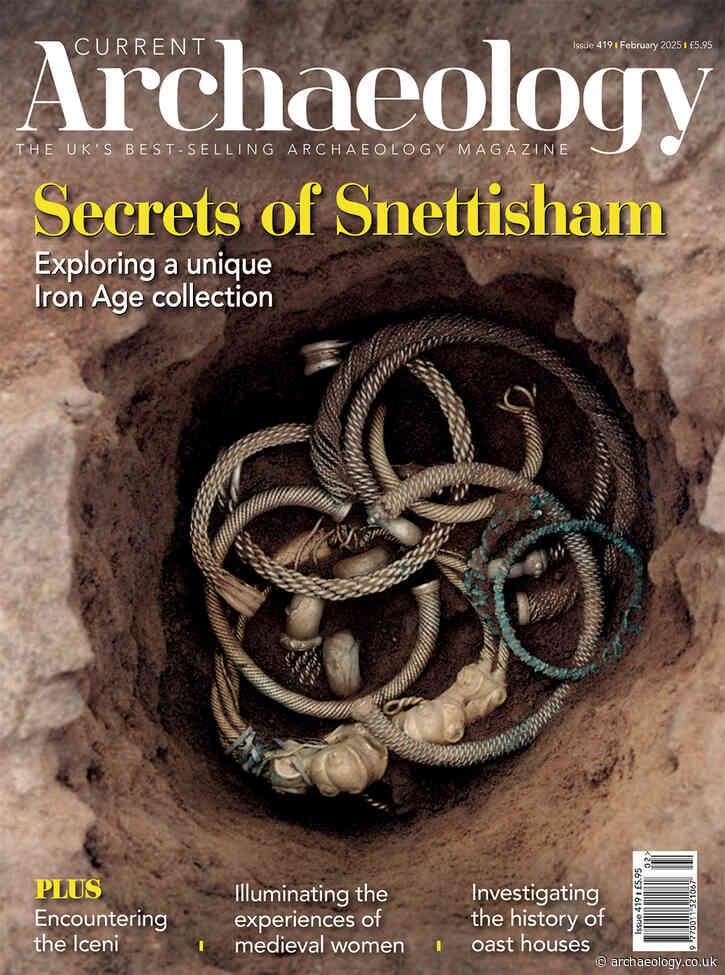 Happy New Year! Our cover story takes us to Snettisham in Norfolk, where a single field has yielded at least 14 Iron Age metalwork hoards. This unique collection has the potential to transform our understanding of ancient artistry and ceremonial practices – and, with analysis of the hoards now published in exciting detail, we explore what has been revealed.
Happy New Year! Our cover story takes us to Snettisham in Norfolk, where a single field has yielded at least 14 Iron Age metalwork hoards. This unique collection has the potential to transform our understanding of ancient artistry and ceremonial practices – and, with analysis of the hoards now published in exciting detail, we explore what has been revealed.
From long-buried metalwork to long-buried stories, we next examine what archives and archaeology can tell us about female experiences -
Fit for an emperor? Excavating a monumental building in Roman Carlisle
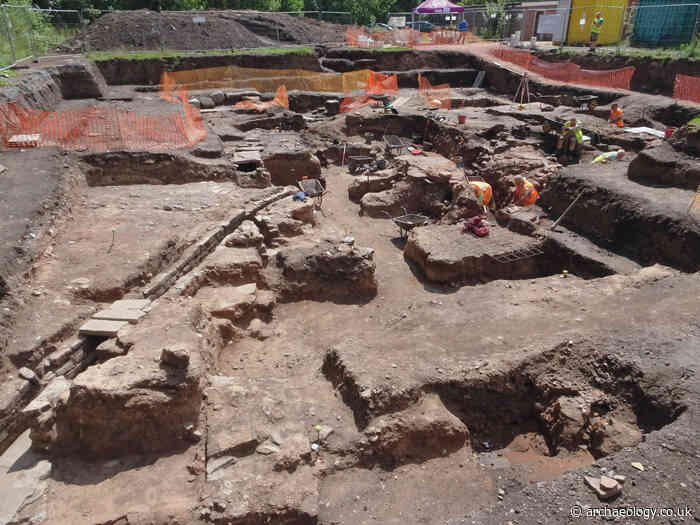 Excavations at Carlisle Cricket Club are uncovering the remains of the largest Roman building ever found on Hadrian’s Wall. Carly Hilts visited the site and spoke to Frank Giecco to find out more.Ongoing archaeological work in Carlisle is revealing the remains of a monumental Roman building dating to the early 3rd century.The story of Roman Carlisle is a tale not of two cities but of two forts. Having brought much of southern England under imperial control in the years after the Claudian i
Excavations at Carlisle Cricket Club are uncovering the remains of the largest Roman building ever found on Hadrian’s Wall. Carly Hilts visited the site and spoke to Frank Giecco to find out more.Ongoing archaeological work in Carlisle is revealing the remains of a monumental Roman building dating to the early 3rd century.The story of Roman Carlisle is a tale not of two cities but of two forts. Having brought much of southern England under imperial control in the years after the Claudian i -
Excavating the CA archives – Star Carr
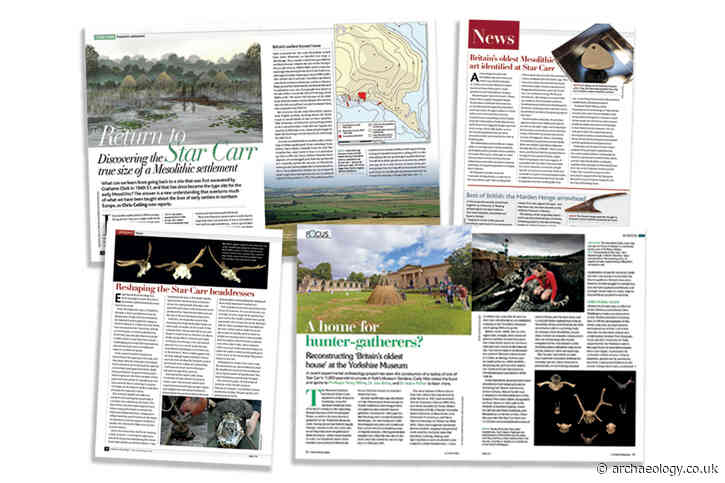 After more than 50 columns exploring the archaeology of the British Isles through a geographic lens, I begin here a new thematic focus: that of ‘great’ sites visited by Current Archaeology down the years. As I neared the end of my tour of the four nations, I reflected on the enduring power of a ‘great’ site. Sometimes it is the physical presence of a location (Maiden Castle springs to mind here); other times, it is the discoveries made (think of Sutton Hoo, whose treasure
After more than 50 columns exploring the archaeology of the British Isles through a geographic lens, I begin here a new thematic focus: that of ‘great’ sites visited by Current Archaeology down the years. As I neared the end of my tour of the four nations, I reflected on the enduring power of a ‘great’ site. Sometimes it is the physical presence of a location (Maiden Castle springs to mind here); other times, it is the discoveries made (think of Sutton Hoo, whose treasure -
Current Archaeology 418 – ON SALE NOW
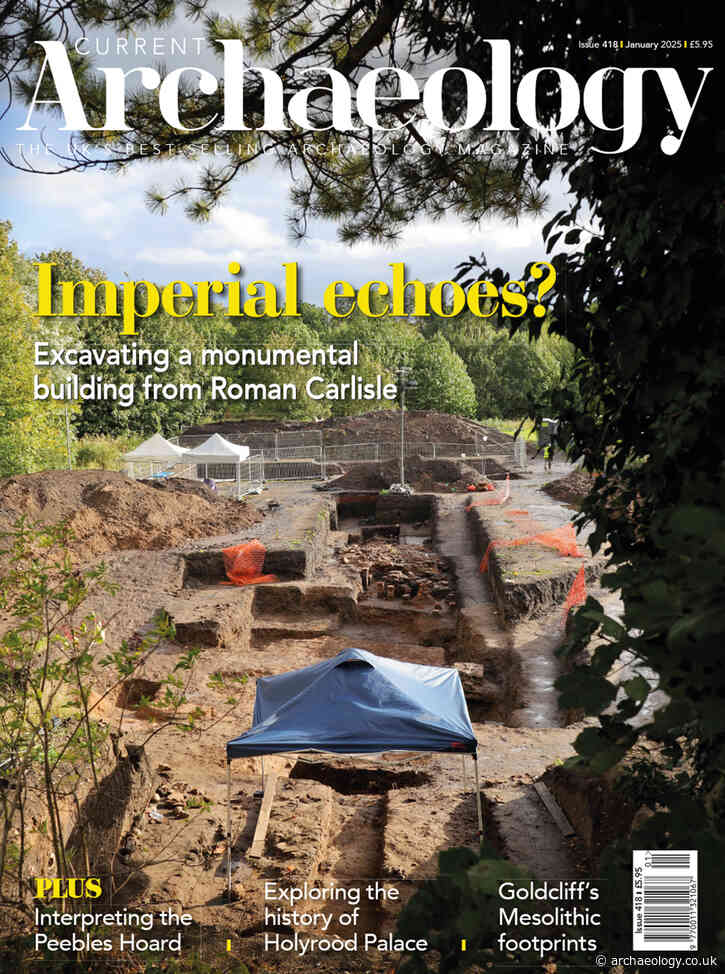 This month’s cover story showcases a monumental mystery from the Roman frontier. Excavations at Carlisle Cricket Club are uncovering the remains of a sumptuous building dating to the early 3rd century. Could its construction be connected to Septimius Severus’ Caledonian campaigns?From the footprint of a massive building to footprints left by Mesolithic hunter-gatherers, we then visit Goldcliff to learn about the ephemeral echoes of ancient journeys that are being documented in the Se
This month’s cover story showcases a monumental mystery from the Roman frontier. Excavations at Carlisle Cricket Club are uncovering the remains of a sumptuous building dating to the early 3rd century. Could its construction be connected to Septimius Severus’ Caledonian campaigns?From the footprint of a massive building to footprints left by Mesolithic hunter-gatherers, we then visit Goldcliff to learn about the ephemeral echoes of ancient journeys that are being documented in the Se -
Current Archaeology 418
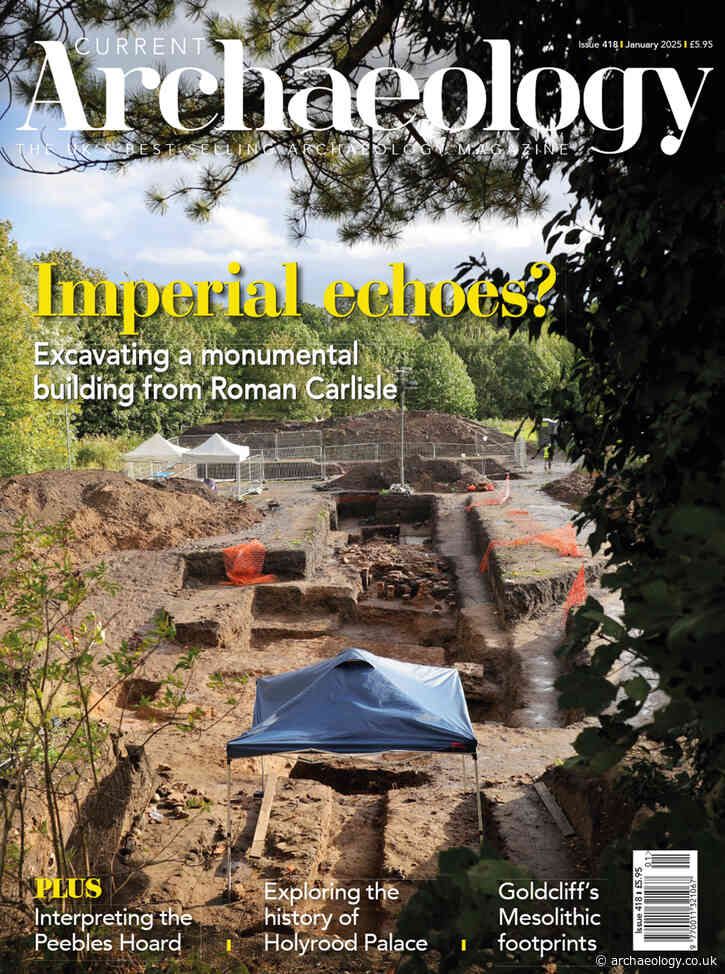 This month’s cover story showcases a monumental mystery from the Roman frontier. Excavations at Carlisle Cricket Club are uncovering the remains of a sumptuous building dating to the early 3rd century. Could its construction be connected to Septimius Severus’ Caledonian campaigns?From the footprint of a massive building to footprints left by Mesolithic hunter-gatherers, we then visit Goldcliff to learn about the ephemeral echoes of ancient journeys that are being documented in the Se
This month’s cover story showcases a monumental mystery from the Roman frontier. Excavations at Carlisle Cricket Club are uncovering the remains of a sumptuous building dating to the early 3rd century. Could its construction be connected to Septimius Severus’ Caledonian campaigns?From the footprint of a massive building to footprints left by Mesolithic hunter-gatherers, we then visit Goldcliff to learn about the ephemeral echoes of ancient journeys that are being documented in the Se -
Rescue Project of the Year 2025 – Nominees
 Rescue archaeology is carried out in areas threatened by human or natural agency. We’ve collated some of the best rescue projects that have been highlighted in Current Archaeology over the past year. Below are the nominees for Rescue Project of the Year.Voting closes on 10 February and all the winners of the Current Archaeology Awards will be announced on 1 March as part of Current Archaeology Live! 2025. Click here to find out more about the event.Once y
Rescue archaeology is carried out in areas threatened by human or natural agency. We’ve collated some of the best rescue projects that have been highlighted in Current Archaeology over the past year. Below are the nominees for Rescue Project of the Year.Voting closes on 10 February and all the winners of the Current Archaeology Awards will be announced on 1 March as part of Current Archaeology Live! 2025. Click here to find out more about the event.Once y -
Research Project of the Year 2025 – Nominees
 This has been another exceptional year for archaeological research. The following are some of the most exciting projects to have featured in CA over the last 12 months – the nominees for Research Project of the Year.Voting closes on 10 February and all the winners of the Current Archaeology Awards will be announced on 1 March as part of Current Archaeology Live! 2025. Click here to find out more about the event.Once you’ve made your select
This has been another exceptional year for archaeological research. The following are some of the most exciting projects to have featured in CA over the last 12 months – the nominees for Research Project of the Year.Voting closes on 10 February and all the winners of the Current Archaeology Awards will be announced on 1 March as part of Current Archaeology Live! 2025. Click here to find out more about the event.Once you’ve made your select -
Book of the Year 2025 – Nominees
 Below are some of the publications we feel most deserve to be recognised for their contribution to the field – the nominees for the Book of the Year award.Voting closes on 10 February and all the winners of the Current Archaeology Awards will be announced on 1 March as part of Current Archaeology Live! 2025. Click here to find out more about the event.Once you’ve made your selection from the nominees below, click here to cast your vote.Click here for lin
Below are some of the publications we feel most deserve to be recognised for their contribution to the field – the nominees for the Book of the Year award.Voting closes on 10 February and all the winners of the Current Archaeology Awards will be announced on 1 March as part of Current Archaeology Live! 2025. Click here to find out more about the event.Once you’ve made your selection from the nominees below, click here to cast your vote.Click here for lin -
Archaeologist of the Year 2025 – Nominees
 Below are the three individuals nominated for 2025’s ‘Archaeologist of the Year’, whose achievements reflect the diverse work taking place within our field.Voting closes on 10 February and all the winners of the Current Archaeology Awards will be announced on 1 March as part of Current Archaeology Live! 2025. Click here to find out more about the event.Once you’ve made your selection from the nominees below, click here to cast your vote
Below are the three individuals nominated for 2025’s ‘Archaeologist of the Year’, whose achievements reflect the diverse work taking place within our field.Voting closes on 10 February and all the winners of the Current Archaeology Awards will be announced on 1 March as part of Current Archaeology Live! 2025. Click here to find out more about the event.Once you’ve made your selection from the nominees below, click here to cast your vote
Spons -
From Samarkand to Sutton Hoo: Exploring the impact of the Silk Roads on early medieval Britain and Ireland
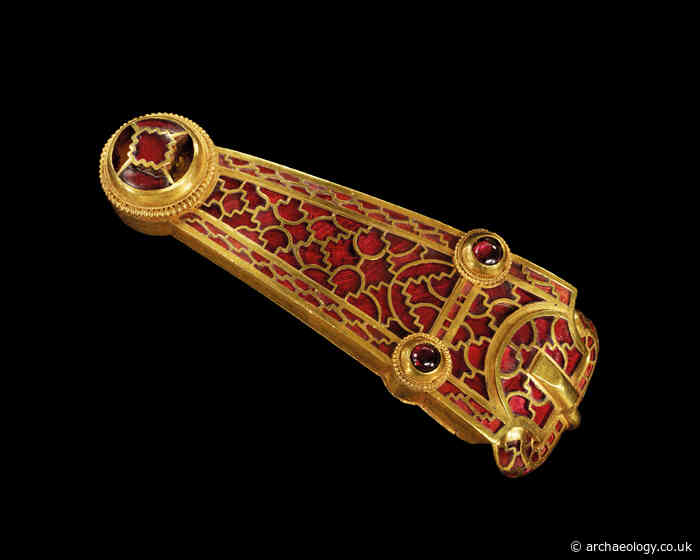 A new exhibition running at the British Museum explores the vast network of cultural and commercial connections that spanned Europe, Africa, and Asia in AD 500-1000. Carly Hilts visited to learn how diverse ideas, materials, and people filtered along these routes to the British Isles.The ornate whalebone box known as the Franks Casket is thought to have been made in 8th-century Northumbria; its images depict scenes from Jewish, Christian, Roman, and northern European narratives.As Willibald wat
A new exhibition running at the British Museum explores the vast network of cultural and commercial connections that spanned Europe, Africa, and Asia in AD 500-1000. Carly Hilts visited to learn how diverse ideas, materials, and people filtered along these routes to the British Isles.The ornate whalebone box known as the Franks Casket is thought to have been made in 8th-century Northumbria; its images depict scenes from Jewish, Christian, Roman, and northern European narratives.As Willibald wat
Follow @archaeology_uk1 on Twitter!

